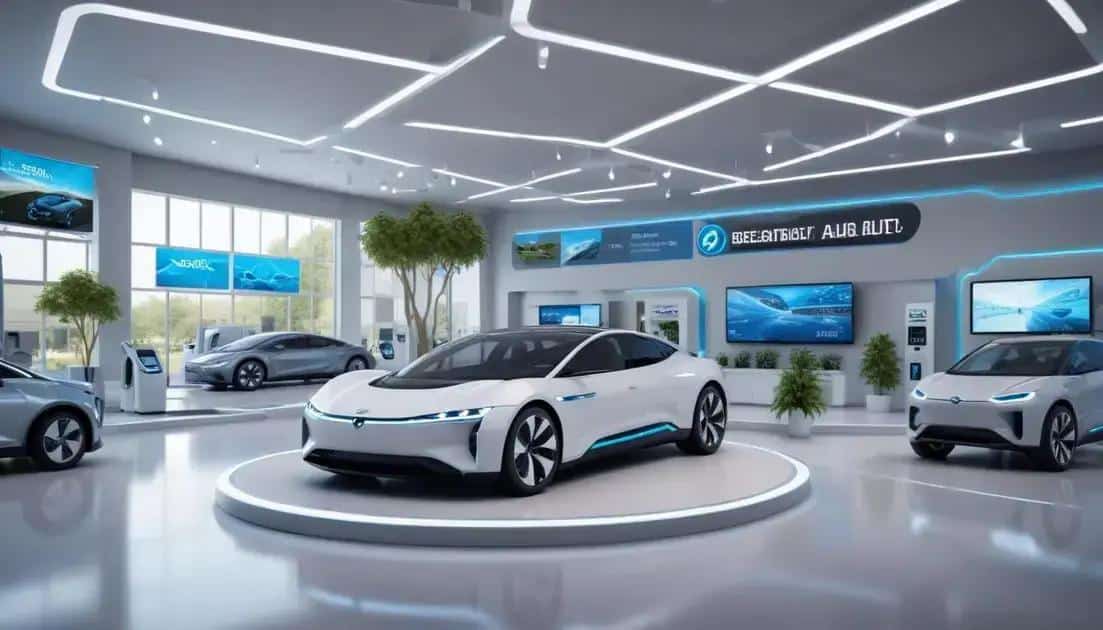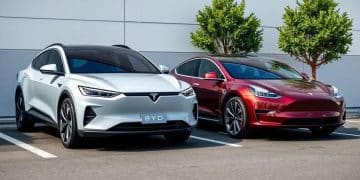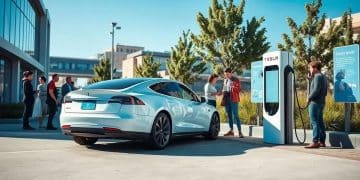Trump suggests auto industry might receive tariff reprieve
Anúncios
Trump suggests that the auto industry might receive a tariff reprieve, which could lead to lower vehicle prices, increased investment in innovation, and a stronger focus on electric vehicles.
Trump suggests auto industry might receive tariff reprieve, raising important questions about the future of car manufacturing. How will this affect you as a consumer and the industry at large? Let’s dive deeper into the implications.
An overview of proposed tariff changes
Understanding the current landscape of the auto industry is crucial, especially with recent discussions surrounding tariff changes. The proposed changes could have significant implications for manufacturers and consumers alike.
What Are the Proposed Tariff Changes?
The proposed tariff changes primarily aim to reduce the burden on the auto industry. This initiative is expected to allow manufacturers to operate more smoothly and boost local production.
Key Points to Consider
- Reduced costs for manufacturers could enhance competitiveness.
- Consumers may see lower prices for vehicles.
- Import tariffs play a crucial role in determining market dynamics.
- Positive effects on employment in the auto sector are anticipated.
As these discussions progress, it’s important to monitor how the proposed changes evolve. Ensuring that these measures benefit both consumers and manufacturers will be a focal point for policymakers.Rethinking tariffs in this industry not only reflects economic strategies but also aims to sustain industry growth superlatively.
Moreover, the shift towards favorable tariffs might inspire further investments in electric vehicles and innovative technologies. Manufacturers can potentially allocate resources to research and development, resulting in advanced and eco-friendly vehicles reaching consumers faster.
Conclusion
To summarize, the proposed tariff changes signal a promising future for the auto industry. With increased profitability and competitive pricing, both manufacturers and consumers stand to benefit from these developments.
How tariffs impact the auto industry

The impact of tariffs on the auto industry is significant and multifaceted. These trade policies can affect everything from manufacturing costs to consumer prices.
Understanding Tariffs
Tariffs are essentially taxes placed on imported goods. They can increase the cost of foreign vehicles, leading to higher prices for consumers. When tariffs are enacted, manufacturers may need to rethink their pricing strategies and supply chain management.
Effects on Manufacturers
- 💰 Increased Costs: Higher tariffs can lead to increased production costs for auto manufacturers
- 🔗 Supply Chain Disruptions: Tariffs can disrupt established supply chains, making it harder to obtain parts and materials
- 💡 Investment Decisions: Manufacturers might delay or halt investments in new technology, fearing reduced profitability
When tariffs rise, manufacturers often face tough choices. They might choose to absorb the costs, which can reduce their profit margins, or pass the expense onto consumers in the form of higher vehicle prices. The ripple effect can change the competitive landscape of the auto industry.
Additionally, consumer behavior is influenced by pricing. As vehicle costs rise, buyers may delay purchases or opt for used cars. This shift in demand can create challenges for manufacturers trying to maintain sales targets.
Long-Term Consequences
Long-term effects of tariffs can include a decline in market competition. If local manufacturers struggle to compete due to inflated costs, this could lead to fewer choices for consumers. Furthermore, a rise in tariffs can hinder the evolution of technologies in the auto industry, particularly in transitioning to electric and autonomous vehicles.
As the auto industry navigates these challenges, it is clear that tariffs play a critical role in shaping the future landscape of automotive manufacturing and sales.
Potential benefits for manufacturers
Examining the potential benefits for manufacturers amidst tariff changes reveals several advantages that could reshape their operational strategies. These benefits can encourage growth and innovation in the auto industry.
Cost Savings and Efficiency
One of the primary benefits of reduced tariffs is the potential for cost savings. When manufacturers pay less in tariffs, they can allocate those funds towards enhancing production efficiency and investing in new technologies.
Market Expansion Opportunities
- Access to new markets: Lower tariffs can open doors to international markets, allowing manufacturers to sell their vehicles at more competitive prices.
- Improved product lines: With reduced costs, manufacturers can develop new and improved vehicles that attract consumers.
- Collaboration with suppliers: Cost reductions can improve relationships with suppliers, leading to better deals and improved supply chains.
Furthermore, by easing tariff burdens, manufacturers might experience a boost in demand. With lower prices, consumers are likely to purchase more vehicles, leading to higher sales volumes.
Additionally, the prospect of increased profit margins allows manufacturers to invest in research and development. This can foster the creation of innovative solutions, particularly in the realm of electric and autonomous vehicles. Advancements in these areas not only benefit manufacturers but also contribute positively to environmental sustainability.
Job Creation and Economic Growth
As manufacturers thrive, they can also focus on expanding their workforce. With increased production and demand, there’s a potential for job creation in various sectors, from assembly lines to research teams.
In summary, the potential benefits for manufacturers arising from tariff adjustments can significantly enhance their competitive positioning. By leveraging cost savings and expanding opportunities, manufacturers can contribute to a more vibrant and innovative auto industry.
Consumer reactions to tariff discussions

Consumer reactions to tariff discussions are important to understand, as they can significantly influence market dynamics. When tariffs are proposed or discussed, many consumers express a range of opinions and concerns.
Impact on Consumer Buying Decisions
Many consumers worry about how tariffs will affect vehicle prices. If tariffs cause prices to rise, some buyers may delay their purchases. This hesitation can create a ripple effect throughout the auto industry.
Shifts in Preferences
- 🚗 Increased interest in alternatives: Consumers may start looking at used cars or more affordable models as new vehicles become more expensive
- 🇺🇸 Awareness of domestic vs. imported: Some consumers may feel compelled to buy domestic vehicles to support local jobs and economies, believing this helps counteract the effects of tariffs
- ⚡ Emphasis on electric vehicles: Discussions about tariffs might prompt consumers to consider sustainable options like electric vehicles, especially if they are seeing reduced costs for these models
As tariffs become a hot topic, many consumers seek information on what these changes will mean for them. They often turn to news outlets, social media, and discussions with friends and family to share their thoughts and concerns about the future of vehicle prices.
Social media platforms are filled with various opinions on tariff discussions. Some consumers voice their frustration about potential price hikes, while others may support tariffs, believing they can protect domestic jobs. This landscape of opinions illustrates how tariffs can affect public sentiment and buying behavior.
Long-Term Consumer Trust
The discussion around tariffs can also impact consumer trust in manufacturers. If consumers feel that companies are not transparent about pricing changes due to tariffs, their loyalty could wane. Building trust is crucial in these discussions, as consumers want assurance that they are receiving fair value.
Ultimately, consumer reactions to tariff discussions are complex and dynamic. What is clear is that these discussions can steer consumer behavior and shape the future of the auto industry.
Economic effects of tariff reprieve
The economic effects of a tariff reprieve can influence various aspects of the auto industry and the broader economy. Understanding these impacts helps to grasp how policy changes shape market behavior.
Immediate Economic Relief
A tariff reprieve offers immediate economic relief for manufacturers. By reducing or eliminating tariffs, companies can lower production costs. This reduction can lead to savings that may be passed on to consumers through lower vehicle prices.
Job Stability and Growth
- Job retention: When companies save on tariffs, they may maintain or even increase their workforce, helping to preserve jobs in the auto sector.
- Increased hiring: A boost in production capacity may lead to the creation of new jobs, benefitting local economies.
- Investment in innovation: With lower costs, manufacturers may invest more in research and development, creating new technologies and automotive solutions.
As companies begin to feel the financial relief from a tariff reprieve, they can focus on growth strategies that further invigorate the economy. Additionally, consumers tend to respond positively to lower prices, resulting in increased sales and consumer spending. This trend can lead to an overall economic boost in related sectors such as finance and retail.
The potential for growth in the electric vehicle market is substantial. With decreased tariffs, manufacturers can increase the production of environmentally-friendly vehicles without the fear of rising costs. This shift not only supports the auto industry but also contributes to sustainability efforts that align with consumer values.
Overall Economic Stability
In the long run, a tariff reprieve can contribute to overall economic stability. With companies able to operate more efficiently, there is less volatility in prices and a more predictable market environment. Healthy competition can emerge as tariffs undermine pricing power, leading to innovation and better options for consumers.
In summary, the economic effects of a tariff reprieve are multifaceted, promoting job stability, encouraging investment, and supporting overall economic health.
Future outlook for the auto industry

The future outlook for the auto industry is shaped by various factors, including technology advancements and changing consumer preferences. As manufacturers adapt to new market realities, their strategies will play a key role in determining success.
Embrace of Electric Vehicles
A significant trend is the shift towards electric vehicles (EVs). Consumers are increasingly interested in sustainable options, prompting automakers to invest in EV technology. This shift not only aligns with environmental concerns but can also lead to potential cost savings for consumers over time.
Technological Innovations
- Autonomous driving: Self-driving technology is becoming more sophisticated, with manufacturers testing and implementing advanced driver-assistance systems.
- Connected cars: The rise of connectivity means cars are now integrated with smart technologies, providing enhanced safety and convenience features.
- Shared mobility: Car-sharing services are growing, changing how people think about ownership and transportation.
The demand for technology is reshaping the manufacturing process. Companies that embrace innovation can gain a competitive edge and improve efficiency. This innovation can also create a more engaging driving experience, attracting consumers who value both technology and sustainability.
Additionally, global market dynamics play a crucial role in shaping the outlook. Trade policies, particularly regarding tariffs, influence costs and pricing strategies for both manufacturers and consumers. If tariffs on imports are reduced, manufacturers might lower prices, which could boost sales.
Market Adaptability
The ability of manufacturers to adapt to changing trends is vital for future success. Companies that can quickly pivot to meet consumer demands for sustainability, technology, and affordability will likely thrive. As younger generations are particularly focused on environmental impact, the industry will need to prioritize sustainable practices.
In conclusion, the future of the auto industry appears promising, with opportunities in electric vehicles, technological advancements, and adaptable business models. By prioritizing innovation and sustainability, manufacturers can position themselves for growth in this evolving landscape.
FAQ – Frequently Asked Questions about Tariffs in the Auto Industry
How do tariffs directly affect car prices?
Tariffs increase the cost of imported vehicles, which manufacturers may pass on to consumers, resulting in higher car prices.
What is the impact of electric vehicles on the auto industry?
The shift towards electric vehicles is driving innovation and changing consumer preferences, creating new opportunities for manufacturers.
Why is consumer reaction to tariff changes important?
Understanding consumer reactions helps manufacturers align their strategies with market demands, ensuring they meet consumer expectations.
What innovations are shaping the future of the auto industry?
Technological advancements such as autonomous driving, connected vehicles, and electric propulsion are key innovations shaping the industry’s future.






